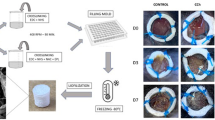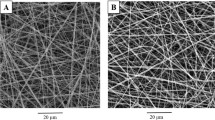Abstract
The current design requirement of cutaneous wound healing is an ideal wound dressing via biodegradable property through which fibroblasts can support, migrate and proliferate. This study aimed to evaluate the effect of the synthesized hybrid scaffold based on chitosan polymer and a natural source of calcium (Ca) and vitamin D on wound healing. To achieve this purpose, three scaffolds include in chitosan (CS), eggshell + chitosan (ES/CS) and chitosan + eggshell + vitamin D (CS/ES/Vit D) were fabricated using the freeze-drying approach. Synthesized scaffolds were characterized by field emission scanning electron microscopy (FESEM), Fourier transformed infrared (FTIR), X-ray diffraction (XRD) and MTT assay. Histological examinations of the wound healing were performed using hematoxylin–eosin (H&E) and Masson's trichrome staining methods on different days in the rat full-thickness skin wound model. Finally, the effect of the synthesized scaffold was evaluated on the TGF-β1 gene expression. The results of the scaffold characterization showed that scaffolds have the homogeneity structure. The MTT assay indicated that the cultured fibroblasts on the ES/CS and Vit D/ES/CS scaffold had viability higher than those cultured on CS. Also, histological studies demonstrated an increased effect on epithelialization and collagen production and accelerated wound healing using designed scaffolds. The TGF-β1 gene expression in all scaffolds was not significantly different between test groups and controls. In general, it can be concluded that the synthesized scaffolds have the potential to accelerate wound healing and can be used as a suitable scaffold in wound management and skin regeneration.
Graphic abstract







Similar content being viewed by others
References
Akbik D, Ghadiri M, Chrzanowski W, Rohanizadeh R (2014) Curcumin as a wound healing agent. Life Sci 116(1):1–7
Wang X-J, Han G, Owens P, Siddiqui Y, Li AG (2006) Role of TGFβ-mediated inflammation in cutaneous wound healing. In: Journal of Investigative Dermatology Symposium Proceedings. vol 1. Elsevier, pp 112–117
Duffy SK, Rajauria G, Clarke LC, Kelly AK, Cashman KD, O’Doherty JV (2017) The potential of cholecalciferol and 25-hydroxyvitamin D3 enriched diets in laying hens, to improve egg vitamin D content and antioxidant availability. Innov Food Sci Emerg Technol 44:109–116
Toiserkani H, Sadaghat F (2013) Chitin and chitosan: structure, properties and applications. Journal of Aquatic Ecology 2(3):40–26
Fahmy M, Jazayeri H, Razavi M, Hashemi M, Omidi M, Farahani M, Salahinejad E, Yadegari A, Pitcher S, Tayebi L (2016) Biomedical Applications of intelligent nanomaterials. Intelligent Nanomaterials 199:245
Sinha T, Ahmaruzzaman M (2015) High-value utilization of egg shell to synthesize silver and gold–silver core shell nanoparticles and their application for the degradation of hazardous dyes from aqueous phase-A green approach. J Colloid Interface Sci 453:115–131
Siregar R, Al-Baarri A, Hintono A, Pramono Y, Abduh S (2016) Purification and protein analysis of ovotransferrin from eggshell membrane of local Indonesia and leghorn hens. Jurnal Teknologi dan Industri Pangan 27(1):87–94
Kozuka M, Murao S, Yamane T, Inoue T, Ohkubo I, Ariga H (2015) Rapid and simple purification of lysozyme from the egg shell membrane. J Nutr Sci Vitaminol (Tokyo) 61(1):101–103
Khanmohammadi M, Khoshfetrat AB, Eskandarnezhad S, Sani NF, Ebrahimi S (2014) Sequential optimization strategy for hyaluronic acid extraction from eggshell and its partial characterization. J Ind Eng Chem 20(6):4371–4376
Crisp M, Demarchi B, Collins M, Morgan-Williams M, Pilgrim E, Penkman K (2013) Isolation of the intra-crystalline proteins and kinetic studies in Struthio camelus (ostrich) eggshell for amino acid geochronology. Quat Geochronol 16:110–128
International A (2006) ASTM E168–06 Standard Practices for General Techniques of Infrared Quantitative Analysis. ASTM International West Conshohocken, PA
ASTM E1252–98, Standard Practice for General Techniques for Obtaining Infrared Spectra for Qualitative Analysis, ASTM International, West Conshohocken, 2013, pp. 1–13.).
E-12 A (1998) Standard Guide for Quantitative Analysis by Energy-Dispersive Spectroscopy. ASTM International
ISO D (2009) 10993–5: 2009—Biological Evaluation of Medical Devices—Part 5: Tests for in vitro Cytotoxicity (ISO 10993–5: 2009). German Version
ISO. Biotechnology — Requirements for evaluating the performance of quantification methods for nucleic acid target sequences qPCR and dPCR. ISO 20395:2019(en). https://www.iso.org/obp/ui#iso:std:iso:20395:ed-1:v1:en
Armentano I, Dottori M, Fortunati E, Mattioli S, Kenny J (2010) Biodegradable polymer matrix nanocomposites for tissue engineering: a review. Polym Degrad Stab 95(11):2126–2146
Ikeda T, Ikeda K, Yamamoto K, Ishizaki H, Yoshizawa Y, Yanagiguchi K, Yamada S, Hayashi Y (2014) Fabrication and characteristics of chitosan sponge as a tissue engineering scaffold. BioMed research international 2014
Apalangya V, Rangari V, Jeelani S, Dankyi E, Yaya A, Darko S (2018) Rapid microwave synthesis of needle-liked hydroxyapatite nanoparticles via template directing ball-milled spindle-shaped eggshell particles. Ceram Int 44(6):7165–7171
Berzina-Cimdina L, Borodajenko N (2012) Research of calcium phosphates using Fourier transform infrared spectroscopy. Infrared Spectroscopy-Materials Science, Engineering and Technology 12(7):251–263
Neacsu IA, Serban AP, Nicoara AI, Trusca R, Ene VL, Iordache F (2020) Biomimetic composite scaffold based on naturally derived biomaterials. Polymers 12(5):1161
Ma Z, Wang W, Wu Y, He Y, Wu T (2014) Oxidative degradation of chitosan to the low molecular water-soluble chitosan over peroxotungstate as chemical scissors. PLoS ONE 9(6):e100743
Fernandes Queiroz M, Melo KRT, Sabry DA, Sassaki GL, Rocha HAO (2015) Does the use of chitosan contribute to oxalate kidney stone formation? Mar Drugs 13(1):141–158
Yarahmadi M, Fakhar M, Ebrahimzadeh MA, Chabra A, Rahimi-esboei B (2016) The anti-giardial effectiveness of fungal and commercial chitosan against Giardia intestinalis cysts in vitro. J Parasit Dis 40(1):75–80
Simana E, Simian R, Portnoy S, Jaffe A, Dekel B (2015) Feasibility Study-Vitamin D loading determination by FTIR-ATR. Инфopмaциoннo-yпpaвляющиe cиcтeмы (3 (76))
Sattary M, Khorasani MT, Rafienia M, Rozve HS (2018) Incorporation of nanohydroxyapatite and vitamin D3 into electrospun PCL/Gelatin scaffolds: The influence on the physical and chemical properties and cell behavior for bone tissue engineering. Polym Adv Technol 29(1):451–462
Ueno H, Yamada H, Tanaka I, Kaba N, Matsuura M, Okumura M, Kadosawa T, Fujinaga T (1999) Accelerating effects of chitosan for healing at early phase of experimental open wound in dogs. Biomaterials 20(15):1407–1414
Chen X-G, Wang Z, Liu W-S, Park H-J (2002) The effect of carboxymethyl-chitosan on proliferation and collagen secretion of normal and keloid skin fibroblasts. Biomaterials 23(23):4609–4614
Azad AK, Sermsintham N, Chandrkrachang S, Stevens WF (2004) Chitosan membrane as a wound-healing dressing: Characterization and clinical application. Journal of Biomedical Materials Research Part B: Applied Biomaterials: An Official Journal of The Society for Biomaterials, The Japanese Society for Biomaterials and The Australian Society for Biomaterials and the Korean Society for Biomaterials 69(2):216–222
Quan TE, Cowper S, Wu S-P, Bockenstedt LK, Bucala R (2004) Circulating fibrocytes: collagen-secreting cells of the peripheral blood. Int J Biochem Cell Biol 36(4):598–606
Pastar I, Stojadinovic O, Yin NC, Ramirez H, Nusbaum AG, Sawaya A, Patel SB, Khalid L, Isseroff RR, Tomic-Canic M (2014) Epithelialization in wound healing: a comprehensive review. Adv Wound Care 3(7):445–464
HOcHsTEiN AO, Bhatia A, (2014) Collagen: Its role in wound healing. Wound Manage 4(1):104–109
Liu M, Luo G, Wang Y, Xu R, Wang Y, He W, Tan J, Xing M, Wu J (2017) Nano-silver-decorated microfibrous eggshell membrane: processing, cytotoxicity assessment and optimization, antibacterial activity and wound healing. Sci Rep 7(1):1–14
Yuan YF, Das SK, Li MQ (2018) Vitamin D ameliorates impaired wound healing in streptozotocin-induced diabetic mice by suppressing endoplasmic reticulum stress. Journal of diabetes research 2018
Borena BM, Martens A, Broeckx SY, Meyer E, Chiers K, Duchateau L, Spaas JH (2015) Regenerative skin wound healing in mammals: state-of-the-art on growth factor and stem cell based treatments. Cell Physiol Biochem 36(1):1–23
Chen Q, Lu H, Yang H (2014) Chitosan inhibits fibroblasts growth in Achilles tendon via TGF-β1/Smad3 pathway by miR-29b. Int J Clin Exp Pathol 7(12):8462
Jiang K, Wang Z, Du Q, Yu J, Wang A, Xiong Y (2014) A new TGF-β3 controlled-released chitosan scaffold for tissue engineering synovial sheath. Journal of Biomedical Materials Research Part A: An Official Journal of The Society for Biomaterials, The Japanese Society for Biomaterials and The Australian Society for Biomaterials and the Korean Society for Biomaterials 102(3):801–807
Tsai C-W, Chiang I-N, Wang J-H, Young T-H (2018) Chitosan delaying human fibroblast senescence through downregulation of TGF-β signaling pathway. Artificial Cells, Nanomedicine and Biotechnology 46(8):1852–1863
Acknowledgment
We gratefully acknowledge the Proteomics Research Center, Shahid Beheshti University of Medical Science for financial support (Grant NO: 12821).
Author information
Authors and Affiliations
Corresponding author
Ethics declarations
Conflict of interest
No potential conflict of interest was reported by the authors.
Ethical approval
Ethical approvals for this study was given by Shahid Beheshti University of Medical Sciences (registered at ethical committee of Shahid Beheshti University of Medical Science NO. IR.SBMU.REC.1396.239).
Additional information
Publisher's Note
Springer Nature remains neutral with regard to jurisdictional claims in published maps and institutional affiliations.
Rights and permissions
About this article
Cite this article
Deilami, A., Niknam, Z., Golchin, A. et al. Novel hybrid scaffold for improving the wound repair process: evaluation of combined chitosan/eggshell/vitamin D scaffold for wound healing. Polym. Bull. 79, 3971–3986 (2022). https://doi.org/10.1007/s00289-021-03692-z
Received:
Revised:
Accepted:
Published:
Issue Date:
DOI: https://doi.org/10.1007/s00289-021-03692-z




